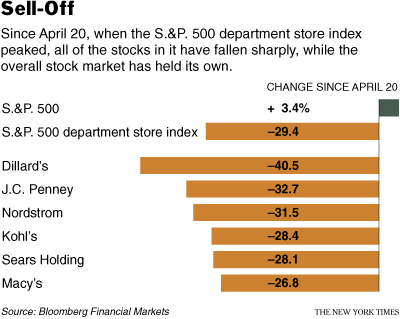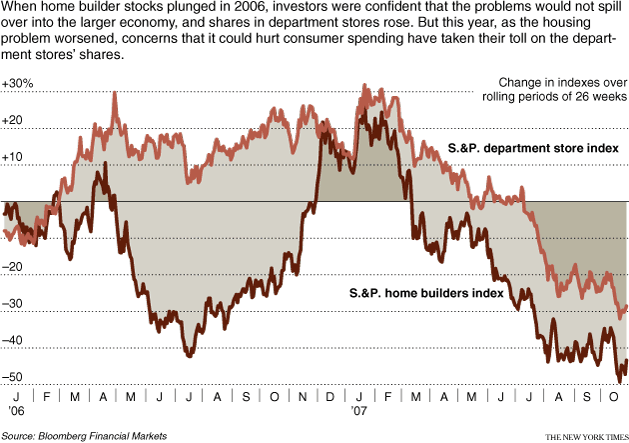| Want to send this page or a link to a friend? Click on mail at the top of this window. |
More Special Reports |
| Posted October 28, 2007 |
OFF THE CHARTS |
| This Time, Housing Is Taking Department Stores Down With It |
By FLOYD NORRIS |
and MICHAEL BARBARO |
When home builders’ stocks plunged in 2006, Wall Street was confident that the problems would not spill over into the larger economy. Exhibit A? Department store stocks rose steadily despite the housing woes.
Not this time around. Housing stocks have fallen again — and this time the department store stocks have marched down with them.
Since April, when investors voiced optimism that the housing slide had been contained, shares of the country’s biggest department store chains have fallen by about 30 percent.
With the sagging prices, investors have rendered a harsh judgment on the coming holiday shopping season, predicting that consumers will severely cut back on spending.
The gloom since April 20 has been spread evenly across the big chains: shares of J. C. Penney are down 33 percent, Macy’s by 27 percent, Kohl’s by 28 percent and Sears by 28 percent.
Robert J. Barbera, the chief economist of the Investment Technology Group, said, “The conventional wisdom of a year ago was that we would have a soft landing in housing.” But today, he said, “the stock market message is a hard landing for housing, with clear damage to consumer discretionary spending.”
 |
In interviews, retail executives conceded that the slumping housing market was taking its toll. “We are in the window-covering business, and you don’t cover windows in houses you don’t build,” said Myron E. Ullman III, the chief executive of J. C. Penney.
But some executives remain at least a little upbeat, complaining that investors are lumping the department stores together. “I believe in the fourth quarter people will continue to buy,” said Terry J. Lundgren, the chief executive of Macy’s. Analysts, he said, “are speculating that the consumer is going to withdraw and not spend at the same levels as she has in the past several seasons.”
And over at Saks, the view is that the housing and credit crisis is somebody else’s problem. “The underlying strength in the luxury market is there,” said Stephen I. Sadove, the chief executive. “That consumer is driven more by confidence in the stock market than in the housing market.”
Investors also appear less certain that Saks will suffer. Its shares are off just 7 percent since April 20.
Still, the stocks of other higher-priced department store chains, which have been largely immune to housing market troubles over the last several years, have plunged this year. Nordstrom is down almost a third.
Economic slowdowns traditionally hurt stores catering to a less affluent customer base, like Wal-Mart and Target. But in a reversal, those discount chains have not done as poorly as department stores.
“The problems have crept up the consumer food chain,” said Bill Dreher, an analyst at Deutsche Bank Securities.
Behind the falling stock prices are slipping sales at stores.
After a strong performance early this year, sales at department stores open at least a year have fallen three of the last six months, according to Deutsche Bank.
 |
The stores have blamed a variety of factors, like an unseasonably warm August and September, which hurt back-to-school clothing sales, and poor sales of household goods, tied to the slowing housing market.
Sales at Macy’s and J. C. Penney have fallen five of the last six months. Kohl’s sales have fallen four of the last six.
____________ |
|
| Some are faring better than others; Sacks is down just 7 percent. | |
____________ |
Not everyone is blaming economics and weather. Mr. Lundgren has pointed to a big marketing campaign last fall to introduce Macy’s in cities like Chicago and Boston, which made for tough sales comparisons this year.
The accompanying charts show that in 2006, when housing troubles first became apparent, shares in home builders plunged but department store shares held their value. The charts show the 26-week change in prices of the Standard & Poor’s 500 home-building index and of the S. &P. 500 department store index.
In 2006, when the home building stocks plunged, the rest of the market, including department stores, kept on rising, and the home builders themselves recovered in late 2006.
But this year, with the credit crisis taking hold over the summer, housing stocks have fallen again, and so have department store stocks.
The overall stock market has held up fairly well. The S. &P. 500 hit a record high earlier this month and has since lost only a small part of its value. That performance, however, may reflect better on the health of American companies than on the American economy. A rising share of profits is coming from foreign operations, while domestic earnings are weak for many companies.
Those who think Americans are likely to reduce their spending point to two related factors. First, in recent years the amount of home equity loans rose by as much as $180 billion a year, with much of the money going to consumption. New loans of that variety are much harder to get now that banks have tightened credit standards and home values are falling in many areas.
Second, the wealth effect of seeing that a house had risen in value helped to encourage spending, even if the money did not come directly from a mortgage loan. Now there may be a reverse effect, as worries about home values lead to a reluctance to spend.
If consumers do cut back, it stands to reason that department stores like Macy’s and Nordstrom may lose market share to lower-priced merchants. That could explain the smaller declines in shares of those chains.
Copyright 2007 The New York Times Company. Reprinted from The New York Times, Business Day, of Saturday, October 27, 2007.
| Wehaitians.com, the scholarly journal of democracy and human rights |
| More from wehaitians.com |